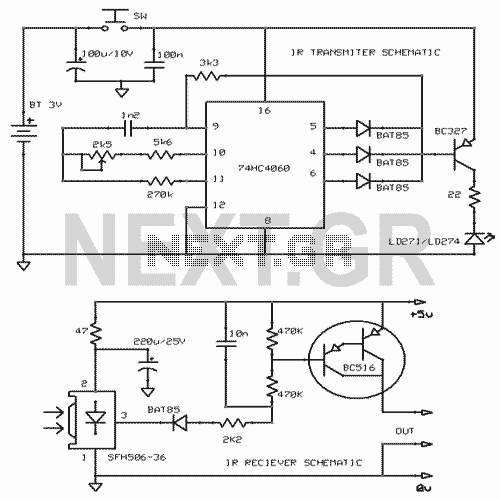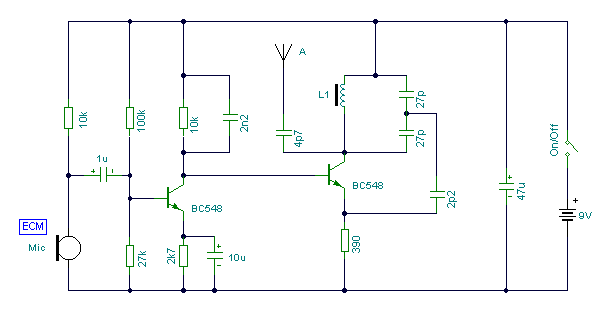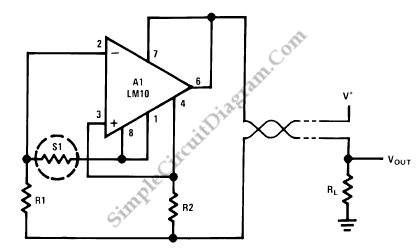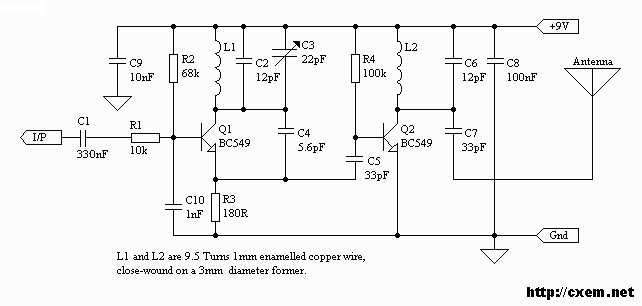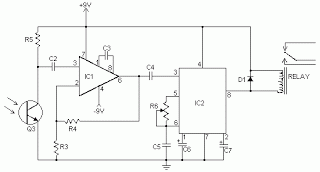
FM Beacon Broadcast Transmitter (88-108 MHz)
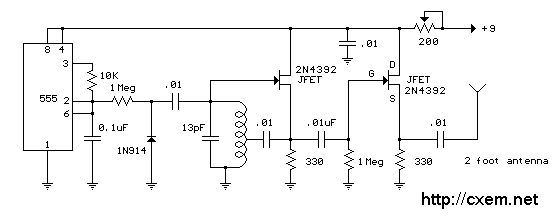
FM Beacon Broadcast Transmitter (88-108 MHz). This circuit will transmit a continuous audio tone on the FM broadcast band (88-108 MHz), which could be used for remote control or security purposes.
The FM Beacon Broadcast Transmitter operates within the frequency range of 88-108 MHz, commonly utilized for FM radio broadcasting. The primary function of this circuit is to generate a continuous audio tone that can be transmitted over the FM band. This feature makes it suitable for applications such as remote control systems and security alerts.
The core components of the transmitter include an oscillator, modulator, and power amplifier. The oscillator generates a stable RF signal at the desired frequency, which is then modulated with the audio tone to encode the information onto the carrier wave. The modulator can be implemented using various techniques, such as frequency modulation or amplitude modulation, depending on the specific requirements of the application.
A key aspect of the design involves ensuring that the transmitter adheres to regulatory standards for FM broadcasting to avoid interference with licensed stations. This may involve the inclusion of filters to limit the bandwidth of the transmitted signal and prevent spurious emissions.
Power amplification is crucial to ensure that the signal can be transmitted over a sufficient distance. The output stage typically consists of a class C amplifier, which provides the necessary gain while maintaining efficiency. The design should also incorporate appropriate heat dissipation methods, as high power levels can generate significant heat.
For practical implementation, the circuit may include additional features such as an adjustable output power level, an antenna matching network to optimize the radiation pattern, and a power supply circuit that ensures stable operation under varying load conditions. The choice of components, such as transistors, capacitors, and inductors, should be made based on their performance characteristics at RF frequencies.
Overall, the FM Beacon Broadcast Transmitter is a versatile circuit that can be adapted for various applications requiring reliable audio transmission over the FM band. Proper attention to circuit design, component selection, and regulatory compliance will ensure effective and efficient operation.FM Beacon Broadcast Transmitter (88-108 MHz). This circuit will transmit a continuous audio tone on the FM broadcast band (88-108 MHz) which could used for remote control or security purposes. Circuit. 🔗 External reference
The FM Beacon Broadcast Transmitter operates within the frequency range of 88-108 MHz, commonly utilized for FM radio broadcasting. The primary function of this circuit is to generate a continuous audio tone that can be transmitted over the FM band. This feature makes it suitable for applications such as remote control systems and security alerts.
The core components of the transmitter include an oscillator, modulator, and power amplifier. The oscillator generates a stable RF signal at the desired frequency, which is then modulated with the audio tone to encode the information onto the carrier wave. The modulator can be implemented using various techniques, such as frequency modulation or amplitude modulation, depending on the specific requirements of the application.
A key aspect of the design involves ensuring that the transmitter adheres to regulatory standards for FM broadcasting to avoid interference with licensed stations. This may involve the inclusion of filters to limit the bandwidth of the transmitted signal and prevent spurious emissions.
Power amplification is crucial to ensure that the signal can be transmitted over a sufficient distance. The output stage typically consists of a class C amplifier, which provides the necessary gain while maintaining efficiency. The design should also incorporate appropriate heat dissipation methods, as high power levels can generate significant heat.
For practical implementation, the circuit may include additional features such as an adjustable output power level, an antenna matching network to optimize the radiation pattern, and a power supply circuit that ensures stable operation under varying load conditions. The choice of components, such as transistors, capacitors, and inductors, should be made based on their performance characteristics at RF frequencies.
Overall, the FM Beacon Broadcast Transmitter is a versatile circuit that can be adapted for various applications requiring reliable audio transmission over the FM band. Proper attention to circuit design, component selection, and regulatory compliance will ensure effective and efficient operation.FM Beacon Broadcast Transmitter (88-108 MHz). This circuit will transmit a continuous audio tone on the FM broadcast band (88-108 MHz) which could used for remote control or security purposes. Circuit. 🔗 External reference
